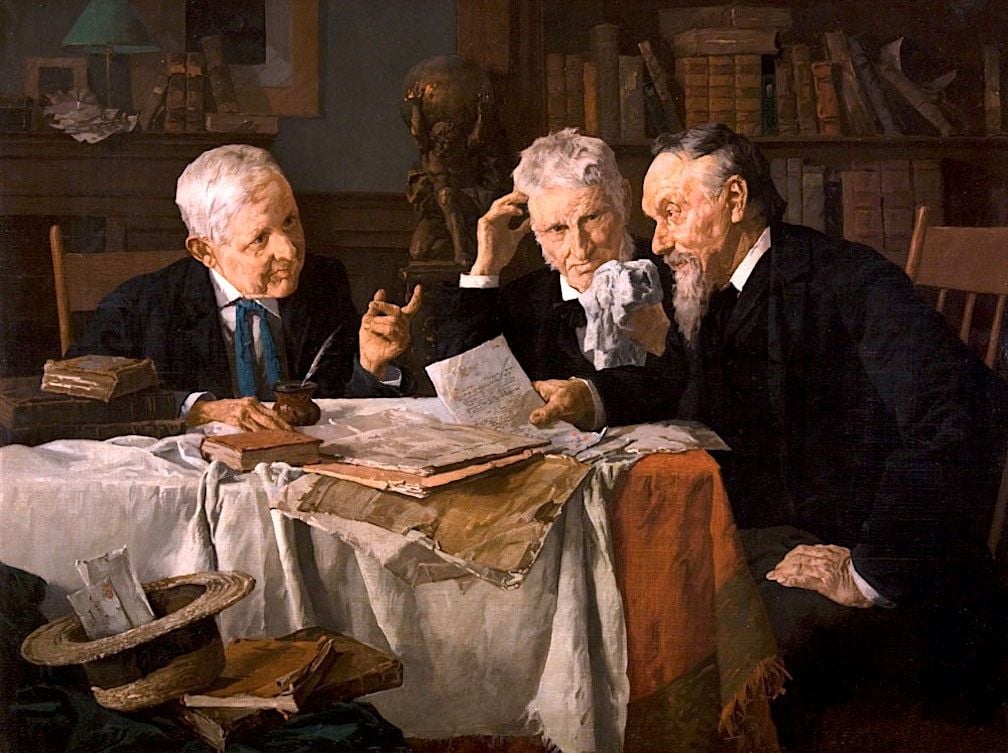by Christopher Ormell (March 2025)

Since Ancient times a tiny subset of determined thinkers has been trying—sometimes against heavy odds—to understand the puzzling world into which they were pitchforked by their parents. On the face of it, this “world” was then (and is now) a vast, immensely complicated, tangled mess. But small signs of order have gradually been identified, and the mental satisfaction induced by cultivating an awareness of these strands of pleasing order and predictability, has generated bits of ‘explanatory mental satisfaction.’
This is the bold side of science … treated as being primarily a search for explanatory insights: looking for hidden patterns which make sense … patterns relating to ourselves and the universe, and providing landmarks around which a synoptic vision of physical reality might begin to form.
Unfortunately in recent times this hopeful— “blue-skies” —vision of science has almost evaporated. A dull awareness has settled-in instead, telling us that this kind of “understanding” is “old fashioned and on the ropes.” Blue sky science has not simply shrunk: it has almost disappeared.
We are now in a world which is still nominally paying for some very expensive “pure” science investigations. But few expect them to deliver significant logical enlightenment. This is a deep pessimism, which does not bode well for the future: for relationships, political stability, the economy, prosperity, well-being … they are all affected by a lack of sweetness and light.
And this evaporation certainly does not bode well for education, because today’s unconscious, lumpen way of responding to challenges … has a negative, across-the-board effect on education. It has become a common assumption that little nowadays makes any kind of sense. Teachers, though, can’t work in this mode. They urgently need to believe in the possibility of satisfying explanations: otherwise genuine education—a process which energises and motivates the learner’s mind—isn’t going to happen. The kind of mental satisfaction which flows from successful explanation, is an ambrosia which should be keeping education thriving. But this appetiser is missing. How can education hope to work … in the arid, anti-explanation mood we have today? This essay explores some grounds for bringing explainability back into favour.
Let’s acknowledge that promising, explanatory science began as a viable quest in Classical Greece. It has since provided a positive outlook for more than two millennia. Many insights have appeared. We tend to take most of these once pricelessly valued, insights, for granted. They have given us a comfortable mental picture of some aspects of reality—parts of reality which were, in bygone times, considered dark, unknown and dangerous. A good example is lightning, which was originally assumed to be the expression of the anger of the Gods. We now have the concepts of electricity and ions … which tell us that it is a natural phenomenon which predictably ends in giant, dangerous discharges.
Some of the most dramatic targets of blue skies science are about the inner (invisible) constituents of rocks, plasmas, plants, microbes, animals and human beings. The classic method of inward scientific explanation needed here has gradually become to envisage the hidden activity of unseen, postulated tiny constituent items … and then to show how this mass of activity—considered as a whole—contrives to add-up-to the visible overall outcome we observe. The “tiny items” are the building blocks which, taken together, constitute the state-of-affairs we are trying to explain. (Examples: biological cells, genes, electrons… ) Each new level of tiny entities displays its own unique, puzzling features. This inexorably points us towards contemplating still tinier entities. So we end-up with the broadly accepted wisdom that a ladder of increasingly invisible items, like cells, chromosomes, atoms, electrons, muons, quarks … really exists. Let’s remember that an earlier, macho, rough empiricism—based on “Seeing is believing!”—was still being loudly espoused by scientific luddites such as Mach and Oswald in the 1900s. Yes, “seeing” is a factor which leads to “believing” (though not since deepfakes) , but “believing” does not stop there. It can be enhanced, using all kinds of quasi-optical and sensitive technology. It is really the discovery of a mass of consistent, rounded, triangulated, evidence (derived from these sources) which has cemented today’s consensus acceptance of bona fide invisibles … as the agents of scientific explanation.
So now the accepted view is that these “tinier and tinier” items are real and potent. Little fleas—it is now agreed—do have smaller fleas, upon their backs to bite ’em…!
This method of scientific explanation (“deconstruction”) has been very successful on many fronts: which is a way of saying that explanations invoking invisibles (like William Harvey’s blood-carrying capillaries) do really explain otherwise baffling phenomena.
Some hasty thinkers, though, have tried to discredit it … by arguing that it implies that everything which happens at microscopic levels will be quasi-mechanical. This is supposed to imply that we, too, must eventually end-up as wholly mechanistic beings. (In the last analysis, though, this notion is based on a common assumption that physical reality is ultimately mathematical. We certainly don’t know this. A better line of reasoning is that this contradiction shows that physical reality is not “fundamentally mathematical.” It may be noted that Leibnitz had already come to this conclusion, with his Monads, four centuries ago.)
Galen explained the heart as a pump, which pushed blood out to the limbs, and then sucked it back in an oscillatory fashion.
Later Harvey showed that the heart was actually a cyclic pump. It caused the blood to circulate round the body by passing it through invisible tiny capillary blood-vessels, and hence back to the heart via the venous system.
Copernicus explained how the Sun was a centre, around which the planets, including the Earth, circulated in their orbits.
Kepler showed that the orbits were elliptical. This flew in the face of scripture, because the Ancients had assumed that the heavenly bodies must move on perfect arcs, and the only arc “perfect enough to be suitable” was a circle.
Newton explained, with astonishing skill, using his newly minted calculus, why the orbits were elliptical. They were the inevitable result of an inverse square gravitational force. This invoked a new form of “mathematic necessity”… and it consigned the previous ancient (crystalline) planetary descriptions to the dustbin of history.
Newton also explained the rainbow, another example of explanation by deconstruction. His account traced the internal reflective path of light inside each raindrop, and thereby neatly explained exactly what we observe on a rainy day when the Sun is out.
Snell’s observation that an underwater beam of light, on leaving the water, changed direction, was explained later as the result of light moving faster in air instead of water.
And so on … an accumulation of explanations based on classical physics followed, lasting for 200 years.
Then a shock arrived. In the 1880s, against all expectations, blue sky science suddenly met an impenetrable mystery. Michelson-Morley’s experiment struck a wall of incomprehension. It showed that light, coming from a source hurtling towards us, didn’t arrive any faster than similar light coming from a static source. This was very disconcerting.
Shortly afterwards, a second shock occurred. Bertrand Russell stumbled on a puzzling fact which shattered a previously assumed 100% comprehensibility of math. He discovered that he couldn’t explain how some sets (the supposed final building bricks of math) were possible. The trickiest one was the set of all sets which were not members of themselves. (It could be easily proved that this was both a member of itself, and not a member of itself! This “shock” was both unexpected and deadly: because math depends, at every point and every move, on avoiding contradictions. Here was a contradiction (which seemed—bizarrely—to be unavoidable). So math was no longer providing its previous blue-chip logical moral support for science.
Eventually Einstein, the most brilliant scientist of the 20th century, managed to “explain” the astonishing relativistic behaviour of light, by inventing spacetime … It was seized-upon with great enthusiasm. It was hailed as an historic break-through.
It worked by reducing time to a kind of space, but it also, co-incidentally, had the worrying side-effect of stamping-out activity of every imaginable kind. This notion that time was inert like space … meant that every physical example of furious activity, was, necessarily, inexorably, going to be treated as a static, immobile state of affairs. (Things we can’t see which are out of sight, are however credited as “being there.” So, if time was a kind of space, events we had not actually observed were also “already there.” They were now part of a timeless, four-dimensional status quo.) This had the effect of taking the spring out of anything which was active, which moved, or which changed. It can only be described as the bitterist of bitter, unintended, “explanatory” side-effects. But the gurus of physics were so be-dazzled by Einstein’s brilliance, that they looked the other way. So the very concept of ‘activity’ was now being officially airbrushed out of science. (And there was a hurtful, personal implication too. This reduction of time to space, also abolished any sense that we, as human beings, have freewill: we have no choice—it says—but slavishly to follow our physically pre-destined lifepaths. Choosing, loving, creating, reforming, politics, morality, jurisdiction, etc. were all suddenly re-classified as illusions, motions we-were-going-to-go-through which had been pre-determined by physical necessity.)
This was an intellectual shock of monstrous proportions. What had so catastrophically tipped the scales? It was that the math of spacetime happened to give the right answers, e.g. the degree to which light bends when passing near a star.
It is said that Einstein himself had qualms about these side-effects of his otherwise all-conquering theory. However the mood of the times (the demoralised aftermath of WW1) was urgent. The gurus of physics desperately wanted to believe in Einstein’s Theory of Relativity.
But there was also an unnoticed collateral damage which came with this: and it was serious. The grand method of inward scientific explanation itself—which summarised the synoptic effect of micro-activity—was taking a hit, because there was now no recognised, recognisable, activity! (Unless you allow the Now Moment tracking through spacetime, something which we can hardly fail to be acutely conscious-of, but which Einstein could never contemplate.) Actual activity had been reduced to bits of four-dimensional fixture. The main method of scientific explanation had been carelessly de-conceptualised into impossibility.
Time was to be henceforward portrayed as an illusion. Suddenly it became the Official Line that there is no such thing as an agreed, objective “Now.”
(Whisper: it is obvious that time is not a dimension, because we can’t move freely in it. Numbers can be attached to it (times, hours, dates), but this does not turn it into a ‘dimension.’ A dimension must connote a ‘degree of freedom.’)
So ever since this dismal, demeaning, universally swallowed, “Relativity Revolution.” we have been (tacitly, officially) living in a bleak, four dimensional wasteland in which nothing ever happens. As a world-view it is demoralising to the nth degree—it downgrades well-being, social justice, morality, decency, creativity, even sport. It is also, incidentally, extremely demoralising for inward-looking blue-skies scientists, because it effectively cancels the highly successful, central method we have historically followed in trying to understand the composition of things, animals and people.
So any “naive idea” that the penny can drop, and that puzzling things can soon make sense … this has (officially) gone. Nothing any longer has, or is expected to have, any sign of rhyme or reason. And this is not just the view of a few depressive Jeremiahs: it is a necessary consequence of the supposedly marvellous, greatest scientific theory.
The common reaction to this? Forget it! Most sensible people have put this insufferable situation distinctly-out-of-mind.
Does it matter? Yes!
A much vaunted theory has been subliminally dangerous: and one of its worst effects has been dangerously to stultify education. It has been doing this for a very long time. (‘Dangerous’ because we need genuine education to pass-on good manners, understandings and competencies to the younger generation.) Instead education has become like mining for facts, which are treated as being stuck “out there” … needing to be dug-up & learnt. They won’t be explained … indeed it is tacitly assumed that they never can be explained. This is a poverty-stricken attitude to the nth degree. It is, no doubt, this unconscious assumption which disinclines today’s behaviouristic instructors in schools from spending sufficient time to make sure that every learner has fluently mastered, internalised and digested the realities they have been so briefly shown.
Some of the allegedly “inexplicable facts,” though, include taken-for-granted unexplainable axioms, like the 3-dimensionality of space, and the ceiling on the velocity of movement. The old illusion, viz. using math as the prime way to model the universe—and hence to try to explain it—has this (mostly unnoticed) downside. Math can only arise from axioms—axioms serve as the “given starting truths” which it needs to begin—but they are items which come with a millstone: they are items which subsequent math is never going to be able to “explain.”
This is a barren, ultra-pessimistic way of looking at the world, but unfortunately it is the one with today’s supposedly “best credentials.” It offers us all a prestigious back-cloth … but closer inspection shows that it implies nihilistic despair.
It is an indescribably bleak world-picture, which first showed itself in 1905. But at the time few saw the full scale of its dreary implications. It was (unobviously) brutal: it negated any hankering-after explanations. They were henceforth dismissed as an exploded dream.
So, this bleak consequence of the fudged spacetime solution to the Michelson-Morley impasse, casts an immensely dark cloud over civilisation. It entails that the quest for cognitive light is hopeless, and that learning programs (e.g. education) can never be a source of joy. (And, in effect, that schools are never going to be able progressively to socialise most of their students into charming, responsible, capable citizens.) It implies that the future is going to be determined only by hard, tedious, painful, endless work. It implies that the complexion of reality will be much more confusing, daunting and complicated than it was in the past … and nothing can (ever) be done about it. The very idea of a clarified, rational view of the world has quietly vanished. Everything is now treated as being naturally, essentially, alien, baffling and hopeless. Only brute force and raw power, it appears, can break-through this quagmire, and make things happen. Reason is out, and a political system based on the assumption that interactions (discussions) between different types of social reasoning can fruitfully determine the way ahead, is doomed to fail. This means that the hope of maintaining a healthy liberal democracy is nil.
Incidentally this is a mindset subliminally accepted in Silicon Valley. The Valley is a powerhouse of able people thinking synoptically about the consequences of new software-driven activities, but they soon come up against a dreary reality—the impossibility of any enlightenment. As a result, these computerists have started crediting the human race with only the most minimal form of intelligence, certainly not the power to explain or to understand anything. Therefore the Valley can only “thrive” (it thinks) if a working artificial alternative (AI) is developed to fill the void. They don’t seem to realise that, because AI is based on rigid math-based neural networks, it is never going to be better than second-best. This math-based pattern-searching logic is miles away from the biological authenticity of human experience. Human thinking is tied umbilically to human needs and emotions, not to mention the energising biological metabolism on which it relies. By contrast AI is, essentially, a type of industrial-scale pattern-seeking similar to numerology … something which was always treated in the past as a foolish, substandard, untrustworthy source of wisdom.
But it is the very real exodus from rhyme and reason—a widespread mostly unspoken trend—which gives AI its superficial credibility. (It can at last recognise objects, places, and people, an amazing feat. But this feat is much less than “showing intelligence”.)
There is another way. It begins with Anti-Math, the new modelling discipline, which is more suited to mimicking the vitality of physical reality than a rigidly venerable, timeless math. It comes with Total Epistemology, a way of conceptualising the physical world which can underpin its own necessary anti-axioms, because the cybernetic fluency which it can deliver in the foreseeable future, is able, in principle, to take over the will-power needed for it to exist.
The starting point: whatever could be the ultimate items (particles) of the physical universe? We know that they are on the final misty level of the ladder composed of unseen entities … which already does much unregistered explaining about how living beings work. There is only one possible, credible answer: the items on the ladder’s final level must be random, incessantly active, 100% unpredictable, shadow streams. They are not “in” any structured framework like space or time, because any such framework would need to be explained, and we are on the final level where further explanation ceases.
We need to cultivate the discipline of building models on this exciting basis. There is only one discipline which can do this job. It is called ‘Anti-Math.’ It can also open the way for a renewal of education … and hence a new, hopeful 21st century outlook which will once again look for rhyme and reason.
Table of Contents
Christopher Ormell is a mathematical philosopher whose first glimpse into the revolutionary idea of anti-math occurred when he was an undergraduate at Oxford, but who has had to refocus repeatedly, to clarify and re-clarify its wider, synoptic implications. This has taken many years. It was the only way to get the core of this mind-changing idea to be taken seriously in the wider philosophic world.
.
Follow NER on Twitter @NERIconoclast
- Like
- Digg
- Tumblr
- VKontakte
- Buffer
- Love This
- Odnoklassniki
- Meneame
- Blogger
- Amazon
- Yahoo Mail
- Gmail
- AOL
- Newsvine
- HackerNews
- Evernote
- MySpace
- Mail.ru
- Viadeo
- Line
- Comments
- SMS
- Viber
- Telegram
- Subscribe
- Skype
- Facebook Messenger
- Kakao
- LiveJournal
- Yammer
- Edgar
- Fintel
- Mix
- Instapaper
- Copy Link







5 Responses
It makes perfect sense to tie the problem of “time” to the question of free will: because what we call “time” precludes alternative behaviors, it makes it impossible to empirically test two competing models that are equally sound logically: that a given action was pre-determined, or that it was freely chosen.
As to Relativity being an obstacle to education — with all the implications for the society articulated in the article — I am very skeptical. I would bet that 99.9999% of educators have not a slightest understanding of Relativity; hence, it cannot influence what they teach. (I don’t understand Relativity either — but than, I am not an educator…)
Lev Tsitrin observes that our lack of room to move about in time means that we can’t be sure whether our actions are pre-determined or not. Actually a famous French philosopher threw himself in front of a car in Paris (which, fortunately, only injured him) to “prove” that he had freewill. It is courteous to interpret this act as a meaningful project, because it is a very brave thing to do. It carries a punch because everyone knows that no sane person would normally do this.
Lev also observes that most teachers don’t understand the theory of relativity. Of course they don’t… but we all live in a common mental flux which ensures that we are aware, to a degree, of other viewpoints. We get a weak sense of the broad attitudes which are being listened-to. It is no secret that the humanities have lost most of the clout they used to carry, and that the scientific establishment says that it is absolutely certain that physical reality is “fundamentally mathematical”. The point I am making is that this is throwing a dismally chill shadow onto how we navigate the dilemmas of life. Also it is no longer the only credible view of “physical reality”: a new 100% abstract logos has recently been found, which allows room for freewill and the humanities.
Thank you for this very interesting article. As a non-scientist, I normally avoid pieces like this as they give me headache (!), but I was attracted to the title which relates––and not just metaphorically––to my own work.
May I say it didn’t disappoint on either count!
My attention was particularly awakened by the section beginning:
“It worked by reducing time to a kind of space…”
The first thing to say is that, as you may be aware, some scientists have noticed the parallel between time conceived in this manner and the experience people may have in life-threatening situations:
https://bigthink.com/neuropsych/life-flashed-before-my-eyes/
(I myself have touched on this phenomenon here:
https://www.newenglishreview.org/articles/the-number-235-the-fall/)
Now, normally, such events occur when we have no choice in the matter as in such situations. But the spatial and illusory nature of time they point to, and the “already there”-ness of unobserved events, I would suggest, are intrinsic to mystical experience. For the mystic, however, such things lead to quite a different conclusion than the despair you find as a scientist.
By chance, this is the subject of my poem next month. I hope you will read it.
Well, in situations of great danger and stress our brains can clearly sometimes go into overdrive. But the idea that the future is already there devalues our freedom, our creativity, our capacity to resist brainwashing and much else. It also favours demagogues and tyrants, by increasing the amount of dumb conformity to the tyrant’s Agenda.
Yes, as you describe it, it’s certainly a regrettable direction that science has taken from the point of view inherited from the Enlightenment. But science has to follow where the evidence leads, leaving the rest to catch up.
At the same time, at a period in our history of great need for a religious revival compatible with science in order to shore up the West’s moral foundations that science has done so much to undermine, it should be of interest that science has itself taken a turn in the direction of what was once thought to be the exclusive province of mysticism.
In Theogony published here I have tried to sketch out a cosmogony that bridges the gap. On the free will point, I say in Part III that we still have an obligation to be the best we can. This is clear from, among others, Akiva ben Joseph: “All is foreseen, but freedom of choice is given.”